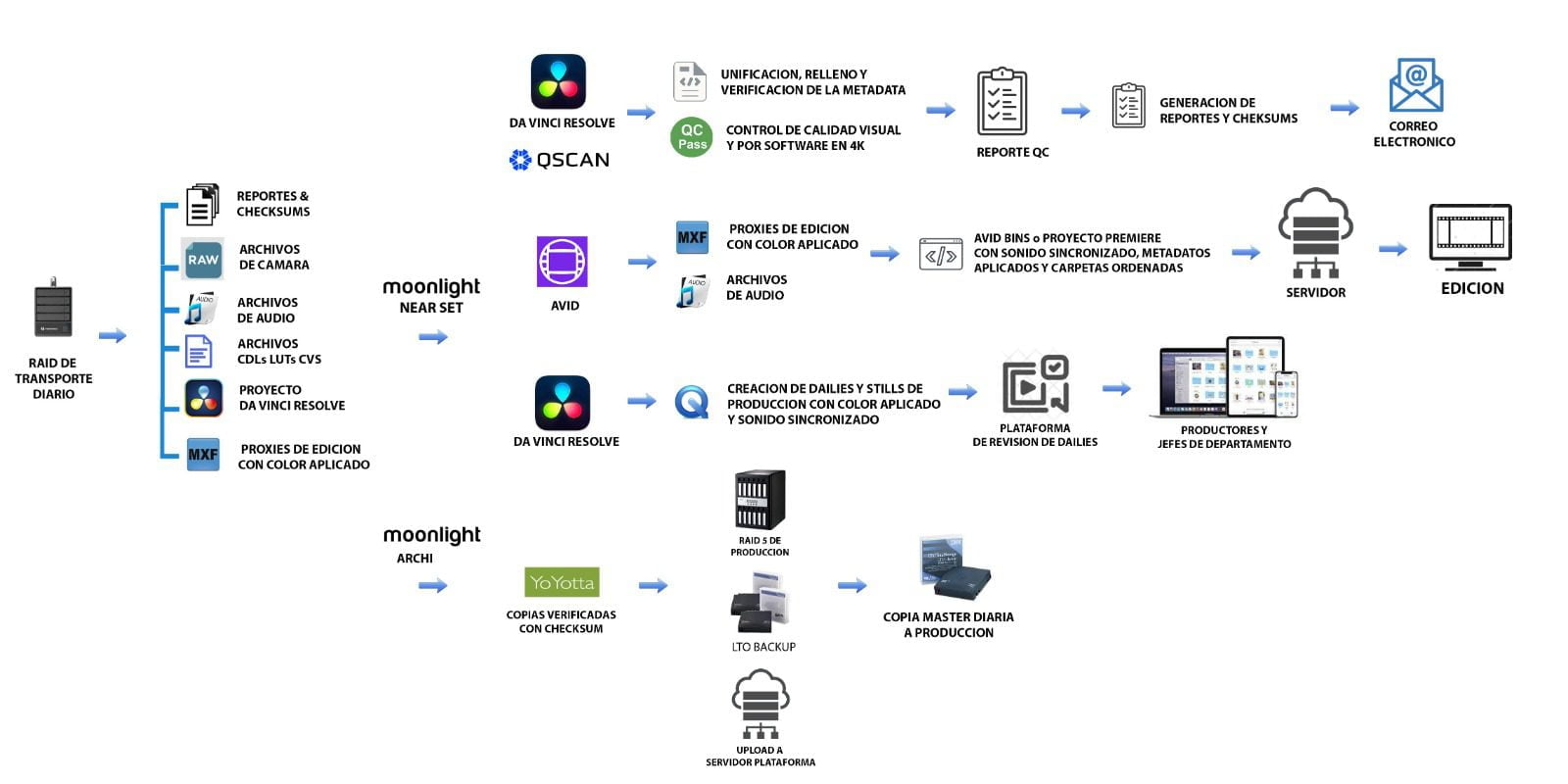NEAR SET / DAILIES LAB
Based on the experience we have gained in these more than 10 years in the creation and supervision of data management and post-production processes, often very complex, we have acquired the knowledge to balance costs, enhance security, and optimize processes that consider not only the shooting but the entire post-production. The complexity of current productions requires us to exercise great care in the decisions we make, as safety standards are contractually binding with platforms and insurers, aiming to ensure excellence in production.
Our workflow is open, meaning that we handle most of the unexpected aspects or processes that cannot be handled on set or during editing. However, it is crucial to understand that both national and international large-scale productions adopt this approach to reduce costs and ensure the proper handling of files through post-production experts, who operate outside the filming environment. In an ideal setting, these experts carry out essential tasks such as copying, quality control, and file generation. It is also important to emphasize the significance of metadata today, as it allows us to optimize time in post-production.
The benefits to this workflow are not only economical but also technical. We streamline the editing process, enabling teams to start editing from the get-go, as all projects are ready. This frees up the team from highly technical tasks like audio synchronization, metadata integration (crucial for post-production success), and, most importantly, quality control, which we conduct in an appropriate environment (monitoring in 4K) by specialists.

The RAID or Transport Disk arrives daily at the end of the shoot at the NEAR SET LAB, which will be located at MOONLIGHT or a nearby location within a maximum of 10 kilometers. Within 12 hours, we will complete all these processes to authorize the deletion of camera cards and start the new day.
These processes include:
1. Copying all the shooting material and file storage generated on the SET and Laboratory to RAID MASTER with verification (checksum).
2. Copying all the shooting material and files generated in the Laboratory to 2 LTOs, with verification (checksum) on tapes labeled with barcodes. We use one tape for each day of shooting and two different brands for greater security – one for copy A and another for B.
3. Uploading all the shooting material and file storage generated on the SET and NEAR SET to the Platform or Studio Server with verification (checksum).
4. Completing all the necessary METADATA, such as shot, take, scene, mechanical lenses, etc. Combining with METADATA from DIT, Camera, Audio, Script, etc. Generating an ALE and CSV file with all the metadata that will accompany post-production.
5. Performing Quality Control (QC) in two steps – first, a software check to verify that the material does not have dead pixels, and then a visual check where we verify the shooting material with synchronized sound on a real-time calibrated 4K monitor. We complete the metadata with this data and generate a report with any found faults.
6. Generating proxies for Editing from the original camera files with set color decisions, including the required printed metadata (burn ins).
7. Creating a daily project in the editing software, usually AVID or Premiere, where we synchronize audio with the generated proxies, ingest complete metadata, and organize the project according to the editors’ requirements. We export AVID BINs or the Premiere project and corresponding ALEs.
8. Generating production Dailies with set color decisions, synchronized sound, required printed metadata (burn ins), and watermark if needed.
9. Uploading files for editing to the server, including Proxies, Audio, Reports, Camera Parts, and editing projects (with updated QC and complete metadata).
10. Uploading Production Dailies and stills to the review platform.
11. Sending summaries, reports, and other useful files (e.g., .mhl, .md5) via email for the DIT to delete the cards and start shooting.
12. Dividing the storage material, handing over LTO copy A (IBM tape) to production, and returning the transport RAID to the set.


